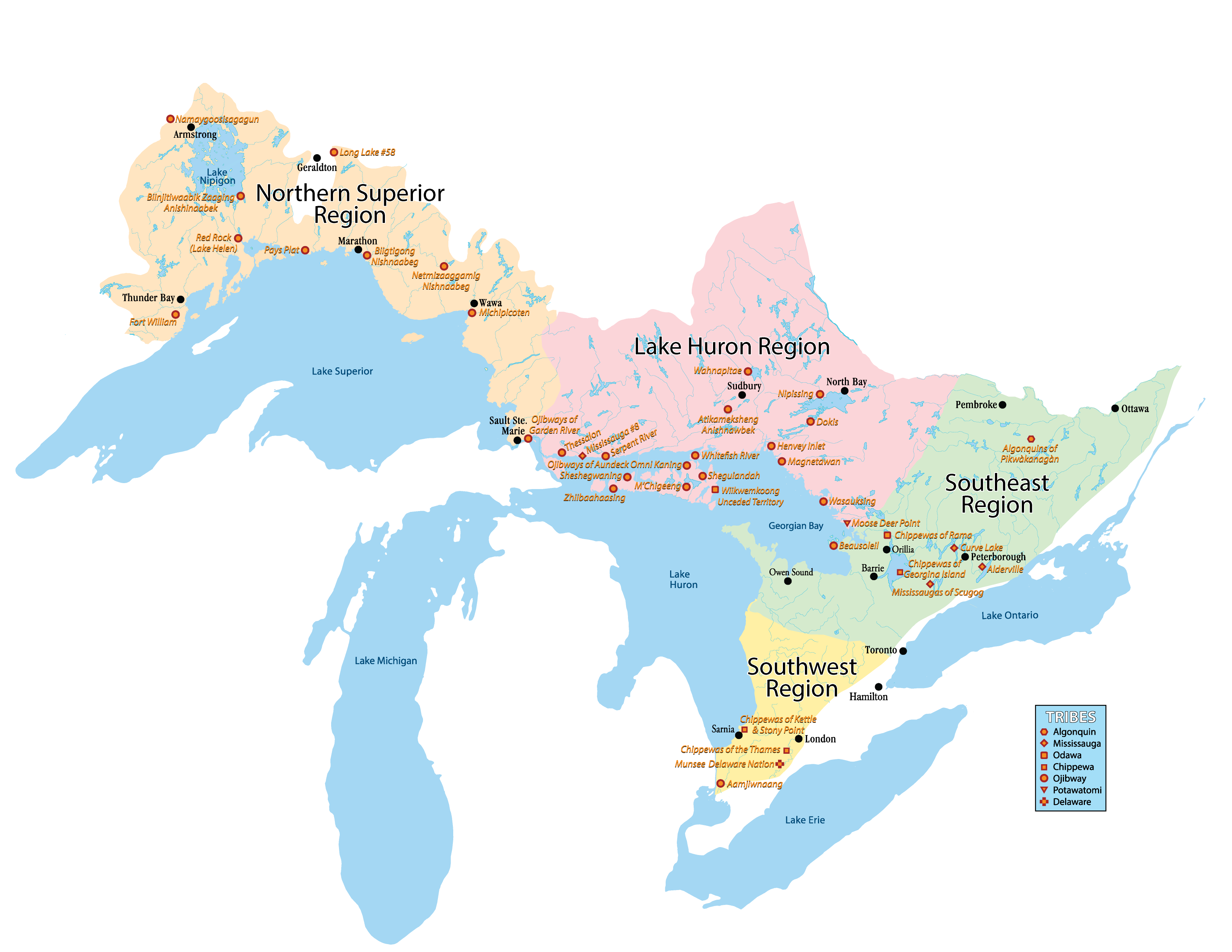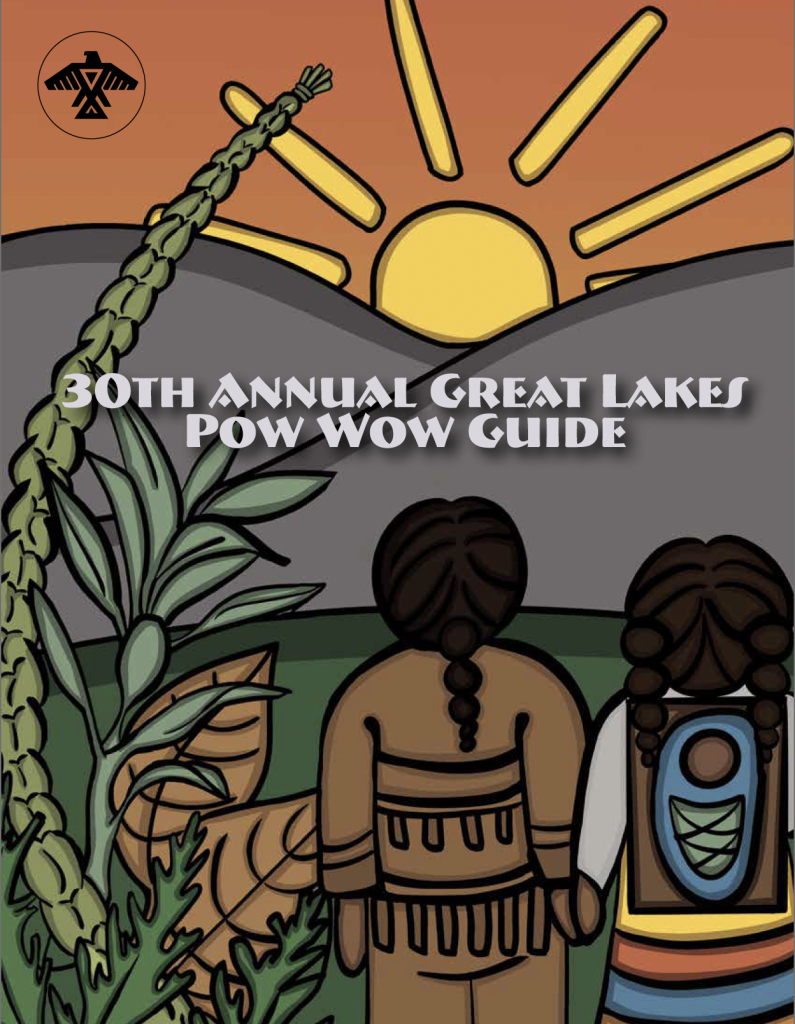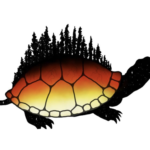Anishinabek Nation
The Anishinabek Nation established the Union of Ontario Indians (UOI) as its secretariat in 1949. The UOI was established because the Anishinabek Nation did not legally exist and a legal entity was required to enter into legally-binding agreements. The Anishinabek Nation is a political advocate for 39 member First Nations across Ontario. The Anishinabek Nation is the oldest political organization in Ontario and can trace its roots back to the Confederacy of Three Fires, which existed long before European contact.
The Anishinabek Nation represents 39 First Nations throughout the province of Ontario from Golden Lake in the east, Sarnia in the south, Thunder Bay and Lake Nipigon in the north. The 39 First Nations have an approximate combined population of 65,000 citizens, one third of the province of Ontario’s First Nation population. The Anishinabek Nation has four strategic regional areas: Southwest, Southeast, Lake Huron and Northern Superior. Each region is represented by a Regional Chief.
The Anishinabek Nation’s head office is located in Nipissing First Nation, just outside of North Bay, Ontario and has satellite offices in Fort William First Nation, Curve Lake First Nation, Munsee Delaware Nation, Garden River First Nation, Sudbury and Thunder Bay. The Anishinabek Nation:
- delivers a variety of programs and services, such as Health, Social Development, Education, Communications, Strategic Initiatives, Economic Development, Lands and Resources, Labour and Market Development, Governance, and Legal, and does this with a complement of approximately 125 staff members;
- provides the necessary forum for collective First Nation action on individual and collective issues by way of resolution from Chiefs-in-Assembly which provides direction to the Grand Council Chief; and
- is governed by a Board of Directors and has a Grand Council Chief and a Deputy Grand Council Chief who carry the day-to-day leadership responsibilities.
HISTORY OF THE ANISHINABEK NATION
The Ojibway (Chippewas), Odawa and Potawatomi Nations formed the Confederacy of the Three Fires of peoples who shared similar languages and territories and who met together for military and political purposes. Each Nation had their role in that Confederacy. The Ojibway (Chippewas) were the providers, the Odawa were the warriors and the Potawatomi were the firekeepers. The Council of the Three Fires had a number of meeting places. One of the most used and the most central was Michilimackinac.
During the 1600s to the 1700s, the Confederacy controlled the hub of the Great Lakes and maintained relations with the Iroquois Confederacy, Sauk Fox, Menominee, Sauk, Winnebago, Sioux, British and French Nations, among others. Occasionally, these international relations would deteriorate into wars, though most frequently, trade and peaceful co-existence prevailed.
By the mid 1700s, the Council of Three Fires became the core of the Great Lakes Confederacy. The Hurons, Algonquins, Nipissing, Sauks, Foxes, and others joined the Great Lakes Confederacy, and after the Treaty of Niagara of 1764, which marked the formal beginning of the peaceful relations with Great Britain, this powerful body provided the British with important allies in times of war and a balance to the Iroquois Confederacy to the south and east.
During the 1800s, traditional structures and procedures changed, wampum became less important as a means of keeping records when more people could read and write, and the government no longer responded to the belts. Gradually, a structured Indian organization came into being, made up of the same Chiefs who had taken part in the older Councils.
The Grand General Indian Council of Ontario and Quebec first met under that name in 1870. In its early days, it met every two years. Later, the meetings were held annually. Almost all of the Lake Huron took part, while the Six Nations Iroquois kept their own traditional Councils and relations with their people across the border. According to the minutes of the annual meetings, much of the Grand Council’s time was spent on reviewing the Indian Act.
In 1949, the Union of Ontario Indians (UOI) was established to replace the Grand General Indian Council. At that time, it represented most of the First Nations in Ontario, with the exception of a number of Independents and isolated First Nations who could not participate. Its objectives were openly political, whose agenda included the elections of Indians to Parliament and the full respect of treaty rights. Once again, conventions were held each year on reserves. Discussions focused on the Indian Act, hunting and fishing rights, medical services, education, and lands issues. The 1951 meeting in Sarnia called for the establishment of an Indian Claims Commission.
In 1969, the UOI was reorganized to reflect the wider scope of Indian politics across the province. By 1972, three other Provincial Territorial Organizations were formed: The Association of Iroquois and Allied Indians, Nishnawbe Aski Nation, and Grand Council Treaty 3.
Today, the Union of Ontario Indians represents 39 Anishinabek First Nations. As of June 2017, Leadership Council gave direction to use the corporate entity of the Union of Ontario Indians for legally-binding agreements, and to use Anishinabek Nation for all other purposes. The goals of this approach are to reinforce the existence of the Anishinabek Nation and to create greater unity amongst the Anishinabek First Nations.




